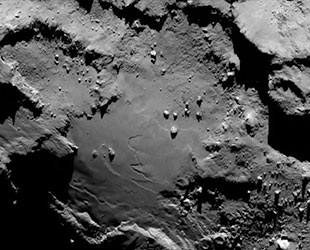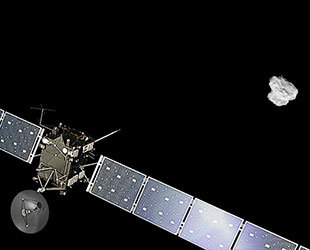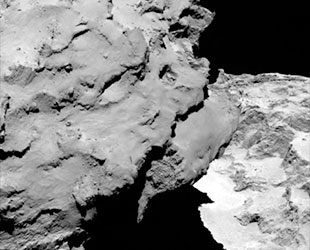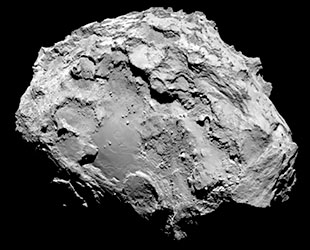August 6, 2014 — After a decade-long journey, Europe's Rosetta spacecraft has reached its target: arriving at the comet where it will make history by entering orbit and then deploying a probe to its surface.
The European Space Agency (ESA) on Wednesday (Aug. 6) confirmed that the robotic spacecraft completed the last of ten rendezvous maneuvers to match the trajectory and speed of Comet 67P/Churyumov Gerasimenko. The final engine burn brought Rosetta about 62 miles (100 km) from the irregularly-shaped comet's surface.
"We're there, we have arrived," Mark McCaughrean, ESA's senior scientific advisor in the space agency's directorate of science and robotic exploration, said. "Ten years we've been in the car, waiting to get to scientific Disneyland. We haven't even gotten out of the car yet and look at what's outside the window. It's just astonishing."
"Europe's Rosetta is now the first spacecraft in history to rendezvous with a comet," stated Jean-Jacques Dordain, ESA's Director General. "Discoveries can start."

House-size boulders, craters, and steep cliffs are visible in this image taken by Rosetta Aug. 6 after arriving at Comet 67P. (ESA) |
The comet and spacecraft are now about 251 million miles (405 million km) from Earth, about half way between the orbits of Jupiter and Mars, speeding toward the inner solar system at nearly 35,000 miles per hour (55,000 kph).
Rosetta will now accompany the Comet 67P/C-G for over a year as they swing around the sun and back out towards Jupiter again.
First, over the next six weeks, the spacecraft will fly two triangular-shaped trajectories in front of the 2.5-mile-wide (4 km) comet, first at its present distance of 62 miles and then at 31 miles (50 km). As Rosetta keeps pace with the icy-rocky body, it will use its onboard instruments to study the surface to identify target landing sites for its "Philae" small lander.
Eventually, Rosetta will attempt a close, near-circular orbit at about 20 miles (30 km) and, depending on the activity of the comet, perhaps come even closer.

Artist's rendition of ESA's Rosetta robotic probe arriving at Comet 67P/Churyumov-Gerasimenko on Aug. 6, 2014. (ESA) |
"Arriving at the comet is really only just the beginning of an even bigger adventure, with greater challenges still to come," said Sylvain Lodiot, ESA's operations manager for the Rosetta spacecraft, adding that they need to learn how to operate in "this unchartered environment" as the probe enters orbit and eventually sends the Philae lander to the surface.
As many as five possible landing sites will be identified by late August, before the primary site is identified in mid-September. The final timeline for the sequence of events for deploying Philae, currently expected for Nov 11, will be confirmed by the middle of October.
"Over the next few months, in addition to characterizing the comet nucleus and setting the bar for the rest of the mission, we will begin final preparations for another space history first: landing on a comet," said Matt Taylor, ESA's Rosetta project scientist.

Close-up detail of Churyumov-Gerasimenko showing the comet's "head" at the left of the frame, which is casting shadow onto the "neck" and "body" to the right of the "rubber duck" body. (ESA) |
In planning since 1993, Rosetta's journey to Comet 67P/C-G began in March 2004 with its launch aboard an Ariane 5 rocket from Korou, French Guiana. Rosetta was originally scheduled to leave Earth a year earlier and visit a different target, Comet 46P/Wirtanen, but its mission was delayed and its destination changed following an unrelated rocket failure.
Comet 67P was found in 1969 by Ukrainian astronomers Klim Churyumov and Svetlana Gerasimenko. It circles the sun once every 6.5 years.
ESA christened the spacecraft after the Rosetta Stone, an ancient Egyptian tablet that was vital to the translation of hieroglyphics. The Philae lander is named after an obelisk discovered on an island in the Nile River. Rosetta mission scientists hope that the orbiter and lander unlock secrets about the history of comets, and the solar system, just as their namesakes helped decipher Egyptian writing.
To reach the comet, Rosetta followed a circuitous route, relying on the gravity assists of a few swing-bys of Earth and one of Mars. Along the way, it flew by two asteroids, sending back data and observations of Steins and Lutetia, before entering a 2.5-year hibernation. It awoke in January 2014.

67P/Churyumov-Gerasimenko by Rosetta's OSIRIS narrow-angle camera on Aug. 3 from a distance of 177 miles (285 km). (ESA) |
Rosetta is expected to stay in orbit around Comet 67P/C-G until the end of 2015.
"Rosetta will continue to accompany the comet until its closest approach to the sun in August 2015 and beyond, watching its behavior from close quarters to give us a unique insight and realtime experience of how a comet works as it hurtles around the sun," Matt said.
Miriam Kramer with Space.com contributed to this article.
